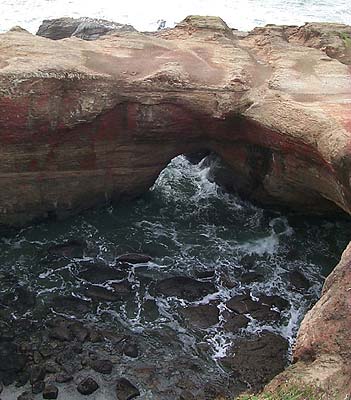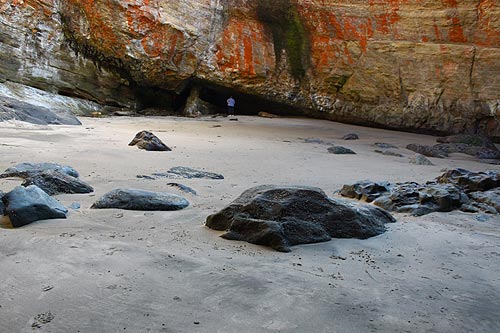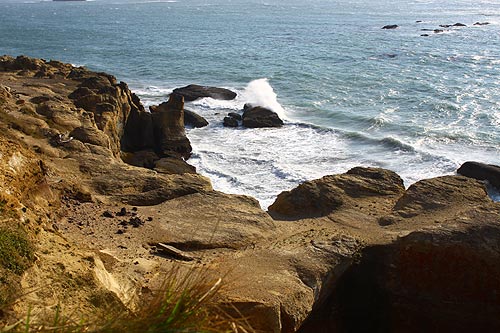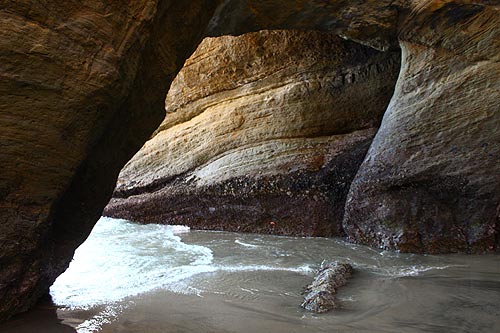Origin of an Oregon Coast Landmark: Devil's Punchbowl
Virtual Tour of Depoe Bay, Gleneden Beach, Lincoln Beach, Otter Rock, Oregon Coast
Historical photo of Devil's Punchbowl courtesy ODOT
Published 05/07/2012
 (Depoe Bay, Oregon) – At one point, it was apparently called “Satan's Cauldron.” At least that's how it was also refered to in a geology guide from the '70s. Now, we mostly know it as the Devil's Punchbowl, the swirling pot of oceanic, boiling madness that gets especially frothy during storms.
(Depoe Bay, Oregon) – At one point, it was apparently called “Satan's Cauldron.” At least that's how it was also refered to in a geology guide from the '70s. Now, we mostly know it as the Devil's Punchbowl, the swirling pot of oceanic, boiling madness that gets especially frothy during storms.
But did you ever wonder how the Punchbowl came to be? How it was formed? And what sort of odd secrets are embedded in its ancient walls?
Essentially it's an old, old – very old – sea cave that fell apart. But there's more to the story.
A large paper on the subject was written in the '70s by Parke D. Snavely, Jr. and Norman S. Macleod for Oregon's geology division, called “Visitor's Guide to the Geology of the Coastal Area Near Beverly Beach State Park, Oregon.”
According to these geology documents from the State of Oregon in 1971, the Devil's Punchbowl is made of bedded sandstone and siltstone of the Astoria Formation. The material that comprises it is maybe as old as 18 million years, having been a kind of fill-in of a variety of sandstone materials and other rocks, coming from eroded basalt from around Oregon, the Gorge and other sources.
Sandstone is much more easily eroded than sturdy basalt, and depending on what else it's mixed with, can be eaten away quite quickly in geologic terms. For instance, the structure known as Jump-Off Joe in Newport is made up of sandstone and has been fading rather fast since it emerged as a headland, perhaps just a few hundred years ago, perhaps longer. Cape Kiwanda at Pacific City too is crumbling fairly quickly.
The Devil's Punchbowl was carved into a sea cave sometime in its distant past, and then somewhere after that the holes in the rock structure just got bigger and bigger as the tide ate at it. Eventually, the top of the sea cave fell in, creating that huge bowl-like structure you now see.

At some point over the millennia this sandstone existed, rock-boring clams made their homes in these channels going into the Punchbowl. Such holes are still visible today during extreme low tide events. Also, wood fossils have been found in the structure of the Punchbowl as well.
Snavely and Macleod say in their paper that beneath the Punchbowl is a weaker-than-usual bedrock, which is called a volcanic breccia because it's a mixture of basalt and other stuff.
“This breccia formed when hot lava was explosively injected into wet sediments,” the scientists said. “This explosive action probably shattered the overlying rocks and produced an easily eroded circular area.”


More on Depoe Bay history, geology in the book series
An interesting sidenote: the Astoria Formation shows up as landmarks like Jump-Off Joe and many of the sea cliffs from Nye Beach, through Moolack Beach and Beverly Beach, up to the Devil’s Punchbowl. It’s yellow and gray, and sometimes a dark gray, depending on what’s mixed in.
Larger fossils have been found in these layers, including a kind of prehistoric hippopotamus and ancient sea lions. Some of these fossils were collected as far north as Gleneden Beach and have been on display at the Smithsonian.

Interesting Fun Facts in Summary
Age of Astoria Formation (and Devil's Punchbowl): perhaps as old as 18 million years.
Cause of Devil's Punchbowl Shape: sea cave where the top fell in
Other Local Geology Facts:
Pillow Basalts of the Central Oregon Coast – Why Depoe Bay looks the way it does.
Cannon Beach's Haystack Rock is the product of a re-eruption: lava flows so huge they burrowed underground and then back up again in a kind of re-eruption, forming the Cannon Beach landmark.
